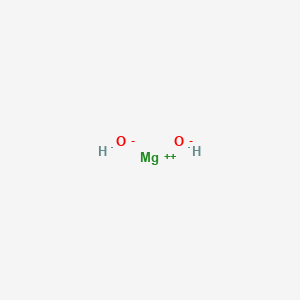



1. Acetamide, 2,2'-((2-hydroxyethyl)imino)bis-(n-(1,1-dimethyl-2-phenylethyl))-n-methyl-, Mixture With Aluminum Hydroxide (al(oh)3) And Magnesium Hydroxide (mg(oh)2)
2. Acetamide, 2,2'-((2-hydroxyethyl)imino)bis-(n-(1,1-dimethyl-2-phenylethyl))-n-methyl-, Mixture With Aluminum Hydroxide And Magnesium Hydroxide
3. Oxaine M
4. Brucite
5. Hydrate, Magnesium
6. Hydroxide, Magnesium
7. Magnesium Hydrate
8. Magnesium Hydroxide
9. Magnesium Hydroxide (mg(oh)4)
1. Magnesiumhydroxide
2. Magnesium (as Hydroxide)
3. Chebi:6637
4. Ins No.528
5. 1909-42-8
6. Oxaine M
7. Ins-528
8. E-528
9. Magnesium Hydrate
10. Magnesium Hydroxide Suspension
11. 1317-43-7
12. Magnesium Hydroxide (gilumag)
13. Phenol,2-[4,6-bis(2,4-dimethylphenyl)-1,3,5-triazin-2-yl]-5-(2-buten-1-yloxy)-
14. Magnesium Hydroxide [jan]
15. Magnesiumhydroxid
16. Magnesii Hydroxidum
17. Magnesium-hydroxide
18. Magnesium(2+) Hydroxide
19. Magnesium Hydroxide Powder
20. Mg(oh)2
21. Chembl1200718
22. Dtxsid4049662
23. Magnesium Hydroxide [ii]
24. Magnesium Hydroxide [mi]
25. Magnesium Hydroxide [fcc]
26. Magnesium Hydroxide 100g
27. Magnesium Hydroxide [hsdb]
28. Magnesium Hydroxide [inci]
29. Magnesium Hydroxide [vandf]
30. Magnesium Hydroxide [mart.]
31. Magnesium Hydroxide Gilumag D211
32. Magnesium Hydroxide Gilumag D212
33. Magnesium Hydroxide Gilumag D213
34. Magnesium Hydroxide Gilumag D214
35. Magnesium Hydroxide Gilumag D611
36. Magnesium Hydroxide Gilumag D661
37. Magnesium Hydroxide Gilumag D671
38. Magnesium Hydroxide [usp-rs]
39. Magnesium Hydroxide [who-dd]
40. Akos015904092
41. Db09104
42. Magnesium Hydroxide [ep Impurity]
43. Magnesium Hydroxide [orange Book]
44. E528
45. Magnesium Hydroxide [ep Monograph]
46. Magnesii Hydroxidum [who-ip Latin]
47. Magnesium Hydroxide [usp Monograph]
48. Ft-0628085
49. Ft-0693469
50. C07876
51. Pharmaceutical Grade Magnesium Hydroxide Hd ~ Usp
52. Q407548
53. J-005906
54. Pepcid Complete Component Magnesium Hydroxide
55. Magnesium Hydroxide Component Of Pepcid Complete
| Molecular Weight | 58.320 g/mol |
|---|---|
| Molecular Formula | H2MgO2 |
| Hydrogen Bond Donor Count | 2 |
| Hydrogen Bond Acceptor Count | 2 |
| Rotatable Bond Count | 0 |
| Exact Mass | 57.9905210 g/mol |
| Monoisotopic Mass | 57.9905210 g/mol |
| Topological Polar Surface Area | 2 Ų |
| Heavy Atom Count | 3 |
| Formal Charge | 0 |
| Complexity | 0 |
| Isotope Atom Count | 0 |
| Defined Atom Stereocenter Count | 0 |
| Undefined Atom Stereocenter Count | 0 |
| Defined Bond Stereocenter Count | 0 |
| Undefined Bond Stereocenter Count | 0 |
| Covalently Bonded Unit Count | 3 |
Magnesium hydroxide can be used as an antacid or a laxative depending on the administered dose. As an antacid, it is used for the temporary relief of heartburn, upset stomach, sour stomach or acid indigestion. As a laxative, it is used for the relief of occasional constipation by promoting bowel movements for 30 minutes and up to 6 hours.
As an antacid, magnesium hydroxide suspension neutralizes gastric acid by reacting with hydrochloric acid in the stomach to form magnesium chloride and water. It is practically insoluble in water and does not have any effect until it reacts with the hydrochloric acid in the stomach. There, it decreases the direct acid irritant effect and increases the pH in the stomach leading to inactivation of pepsin. Magnesium hydroxide enhances the integrity of the mucosal barrier of the stomach as well as improving the tone of both the gastric and esophageal sphincters. As a laxative, the magnesium hydroxide works by increasing the osmotic effect in the intestinal tract and drawing water in. This creates distension of the colon which results in an increase in peristaltic movement and bowel evacuation.
Antacids
Substances that counteract or neutralize acidity of the GASTROINTESTINAL TRACT. (See all compounds classified as Antacids.)
Absorption
About 15%-50% of magnesium hydroxide is absorbed very slowly through the small intestine.
Route of Elimination
After oral administration, up to 50% of the magnesium hydroxide suspension may be absorbed as magnesium ions through the small intestines and then rapidly excreted in the urine through the kidneys. The unabsorbed drug is mainly excreted in the feces and saliva.
Volume of Distribution
The peak action and distribution of magnesium hydroxide are variable.
Clearance
Magnesium hydroxide is mainly excreted in the urine by the kidneys. Since the kidneys play a major role in its clearance, individuals with renal failure are at risk of hypermagnesemia with long term consumption as the appropriate amounts of magnesium may not be excreted.
Unless a patient is deficient in magnesium, very little is absorbed by the intestine. Overall, about 15%-50% of the magnesium hydroxide suspension is absorbed systemically. However, it does not undergo any metabolism as it is rapidly excreted in the urine.
N/A
The suspension of magnesium hydroxide is ingested and enters the stomach. According to the amount ingested, the magnesium hydroxide will either act as an antacid or a laxative. Through the ingestion of 0.5-1.5 grams (in adults) the magnesium hydroxide will act by simple acid neutralization in the stomach. The hydroxide ions from the magnesium hydroxide suspension will combine with the acidic H+ ions of the hydrochloric acid made by the stomachs parietal cells. This neutralization reaction will result in the formation of magnesium chloride and water. Through the ingestion of 2-5 grams (in adults) the magnesium hydroxide acts as a laxative in the colon. The majority of the suspension is not absorbed in the intestinal tract and will create an osmotic effect to draw water into the gut from surrounding tissues. With this increase of water in the intestines, the feces will soften and the intraluminal volume of the feces will increase. These effects still stimulate intestinal motility and induce the urge to defecate. Magnesium hydroxide will also release cholecystokinin (CKK) in the intestines which will accumulate water and electrolytes in the lumen and furthermore increase intestinal motility.
